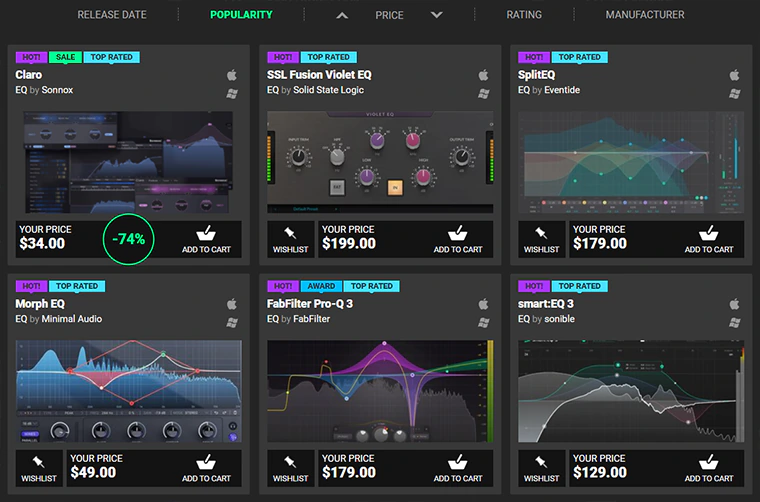The history of distortion plugins can be traced back to the early days of rock and roll.
To create new sounds, guitarists pushed their amplifiers to their limits. This led to the development of the first distortion pedals, like the Fuzz Face and the Tube Screamer. Pedals like these used analog circuitry to create distorted tones, from warm overdrive to searing fuzz.
In short, distortion plugins alter the sound of a musical instrument or vocal recording. Signal processing techniques enable distortion plugins to produce a wide range of sounds, from subtle overdrive to intense, fuzzed-out distortion. Many different types of music have used this effect, from rock to electronic to pop.
The Early Days of Distortion in Music Production (History of Distortion Plugins)
Distortion has been used in music production since the early days of rock and roll. In the 1950s, guitarists started intentionally overdriving their amps, creating a gritty, crunchy sound that would become a hallmark of rock music. As part of this process, the amplifier was turned up past its normal operating range, causing the signal to become distorted. This is known as “dirtying up” the signal.
As rock music became more popular, musicians experimented with distortion. There were some who used preamplifiers to boost the signal before it hit the amplifier and some who used pedals to add distortion at the input. Those early distortion devices were often primitive and unreliable, but they paved the way for more sophisticated ones.
In the 2000s, digital technology marked an important turning point in the history of distortion in music production. Using computers and digital audio processing, musicians were able to create complex and detailed distortion effects. By using these digital plugins, producers were able to create unique sounds and experiment with new techniques that were not possible with analog devices.
With the passage of time, the market for distortion plugins grew, with many independent developers creating their own tools and selling them online. There are tons of distortion plugins out there now, from simple one-knob devices to complex multi-effect processors. You’ll find a plugin that can deliver the sound you’re after, whether you want a subtle overdrive or a full-on, ear-shredding distortion.
Music producers have used distortion since the early days of rock and roll, and it remains an essential component of modern music.
Rise of Digital Technology and the Development of Distortion Plugins
In the music industry, digital technology has had a tremendous impact on the development of distortion plugins. Historically, musicians had to rely on physical hardware or creative recording techniques to achieve distorted sounds. As a result, there were often limited options and unpredictable outcomes. In recent years, however, the advent of digital technology has enabled musicians to access a variety of distortion plugins that can easily be integrated into their musical production processes.
As one of the key advantages of digital technology, it is possible to create and store complex algorithms capable of accurately simulating various types of distortion. The result has been a range of distortion plugins offering a wide range of options and flexibility. In some cases, plugins mimic the sound of classic guitar amps and pedals, while in others, they provide users with more experimental options to create unique and creative sounds.
Furthermore, the rise of the internet has contributed significantly to the development of distortion plugins. Previously, musicians had to purchase new plugins from physical stores or catalogs. Their choices were often limited, and they had to rely on the expertise of the sales staff to make informed decisions. The internet, however, has made it much easier for musicians to research and compare different plugins, allowing them to make more informed choices.
As the plugin market has grown, distortion plugins have also grown in popularity. In the past, the plugin market was dominated by a few large companies. With the advent of the digital age, it has become easier for independent developers to create and sell their own plugins, which has resulted in a more diverse and competitive marketplace. The result has been an increase in the number of distortion plugins available, as well as a greater focus on quality and innovation.
Generally speaking, the rise of digital technology and the growth of the internet have contributed significantly to the development of distortion plugins. Today, musicians have access to a wide range of high-quality options, which can help them create sounds that are more creative and innovative. It is likely that distortion plugins will continue to evolve as digital technology continues to advance.
Independent Developers and the Growth of the Plugin Market
Over the past decade, the plugin market has grown significantly, with independent developers creating high-quality, innovative products. Many factors are contributing to this growth, including digital technology’s increasing accessibility and independent music production’s rise.
Plugins were often prohibitively expensive and only available through large, established companies in the early days of music production. As digital technology has become more accessible, independent developers have been able to create their own plugins, offering unique and specialized products at more affordable prices. As a result, a wide range of plugins is now available to musicians and producers.
The rise of independent music production has been one of the key drivers of this growth. Musicians are now able to create and release their own music without the need for a major label due to the advent of digital recording and distribution platforms. As a result, there has been a growth in the demand for affordable, high-quality plugins that can help them achieve professional-sounding results.
Furthermore, online marketplaces, such as the Plugin Alliance and Plugin Boutique, have contributed to the growth of the plugin market by allowing independent developers to sell their products directly to users.

Independent developers can now compete with larger, established companies on a level playing field.
Users now have a wider range of options and more affordable prices thanks to the rise of independent developers on the plugin market. Additionally, independent developers have been able to create unique and specialized products that may not have otherwise been possible within a larger organization.
Overall, the expansion of the plugin market and the rise of independent developers has been a positive development, providing musicians and producers with increased options and greater flexibility in their music production. In the years to come, this growth is likely to continue due to the continued advancement of digital technology.
Conclusion
There has been a lot of innovation and experimentation in the history of distortion plugins. Throughout history, distortion plugins have played a crucial role in shaping the sound of popular music, from the first fuzz and overdrive pedals to modern digital sound design. As technology continues to evolve, distortion plugins will become even more powerful in the future.




